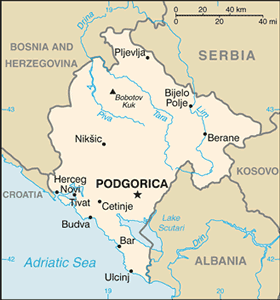The Geography of Montenegro
The Geography of Montenegro
Montenegrin Geography
Location: Southeastern Europe, between the Adriatic Sea and Serbia
Geographic coordinates: 42 30 N, 19 18 E
Map references: Europe
Area: total: 14,026 sq km land: 13,812 sq km water: 214 sq km
Area - comparative: slightly smaller than Connecticut
Land boundaries: total: 625 km border countries: Albania 172 km, Bosnia and Herzegovina 225 km, Croatia 25 km, Kosovo 79 km, Serbia 124 km
Coastline: 293.5 km
Maritime claims: territorial sea: 12 nm continental shelf: defined by treaty
Climate: Mediterranean climate, hot dry summers and autumns and relatively cold winters with heavy snowfalls inland
Terrain: highly indented coastline with narrow coastal plain backed by rugged high limestone mountains and plateaus
Elevation extremes: lowest point: Adriatic Sea 0 m highest point: Bobotov Kuk 2,522 m
Natural resources: bauxite, hydroelectricity
Land use: arable land: 13.7% permanent crops: 1% other: 85.3%
Irrigated land: NA
Natural hazards: destructive earthquakes
Environment - current issues: pollution of coastal waters from sewage outlets, especially in tourist-related areas such as Kotor
Environment - international agreements: party to: Air Pollution, Biodiversity, Climate Change, Climate Change-Kyoto Protocol, Desertification, Hazardous Wastes, Law of the Sea, Marine Dumping, Marine Life Conservation, Ozone Layer Protection, Ship Pollution signed, but not ratified: none of the selected agreements
Geography - note: strategic location along the Adriatic coast


